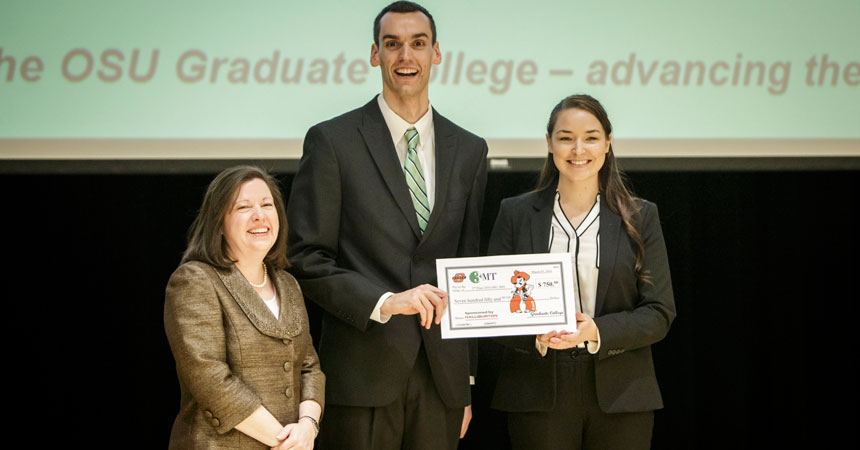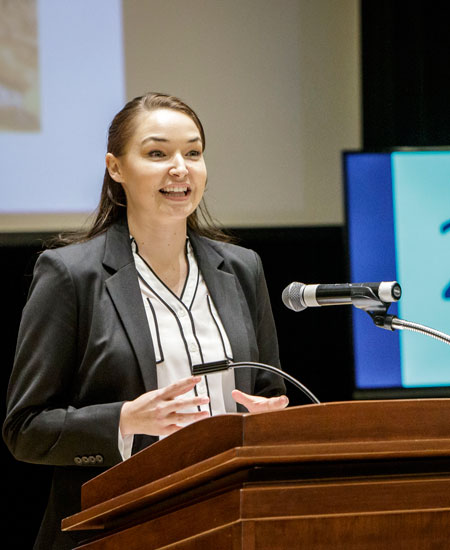Safety First
Tuesday, March 21, 2017

It’s no question that great risk is involved in successfully getting people to deep space for extensive missions.
In the 2030s, NASA is planning to send people outside Earth’s orbit — specifically Mars — but much must be done before it can happen.
Of course, keeping astronauts safe — especially when they face exposure to high doses of radiation — is a top priority.
Kahli Remy, a physics doctoral candidate, addressed this issue in her presentation, “High Dose Radiation Effects in Tissue Equivalent Materials.” She won first place in the 2016 College of Arts & Sciences 3 Minute Thesis Finals and second place universitywide.
“It is no surprise to me that Kahli did so well,” says Stephen McKeever, a MOST Chair of Experimental Physics, Regents Professor and Noble Research fellow who served as Remy’s research adviser throughout the entire process. “Her enthusiasm shines through in the lab.”
McKeever along with Eduardo Yukihara, associate professor in OSU’s physical sciences department, and others helped Remy prepare her thesis, attended her competitions and gave her beneficial feedback.
Remy’s thesis centered on the high levels of radiation that could be found in space and identifying and testing materials that could absorb radiation like human tissue does. In her 3MT talk, she defined radiation as “simply waves or subatomic particles that transport energy to another entity, whether it’s an astronaut or spacecraft component.”

To Remy, the 3MT was more of an application-based presentation, which is much more than simply explaining the science of what one’s doing — a concept that can be difficult to play out in the realm of science.
“This really broke the ice for me regarding presenting in front of people I don’t know,” Remy says.” It was a good first step in gathering information, organizing it in a concise manner — what I want to talk about and why I want to talk about it — and hitting important points, which is hard sometimes in science.”
She focused on relaying her message to the audience in a conversational manner — in a way that is relatable, easily understandable and publicly relevant. It left the audience with a call to action — and she did it all in three minutes with only one static slide.
In particular, she spoke about the kinds of particle radiation doses that astronauts would experience during prolonged deep space missions and why it’s an important, relevant issue that needs to be addressed and resolved.
It’s no question that space radiation exposure is extremely hazardous, but it becomes even more so when we’re not entirely sure what levels will be encountered.
The bottom line is that high dose radiation exposure passes through the body’s cells and DNA and can kill them — the higher the dose, the faster cells die along with a lower probability of surviving.
Remy highlighted the bigger risks of exposure, such as increased risk for cancer and the possibility of acute radiation sickness during an actual mission —including the risk of cognitive issues if particles were to directly affect the brain.
She explained the process of how she would dose specific materials with various types and high levels of radiation, and then devise an energy deposition profile to study how particles deposit energy and thus damage materials, i.e., human tissue. The big picture: she’ll be able to equally compare how such materials/tissue are damaged by certain types of radiation at differing levels with what will happen to the astronauts and how much radiation they can endure.
Remy hopes her research will lead to more concrete safety measures for astronauts.
Originally from Leona Valley, Calif., Remy completed her undergraduate degree at Southern Arkansas University, where she majored in engineering physics.
Soon after, Remy ventured to OSU for graduate school — a simple choice she made after visiting campus for the first time.
“She is a leader among the students and is always ready with a smile and a laugh,” McKeever says. “Her hard work, persistence, patience and communication skills — and her grasp of the ‘big picture’ — mean that she is on her way to becoming a very capable research scientist and educator. With her positive personality, she will be a great success.”
Photo Courtesy / Oklahoma State University
